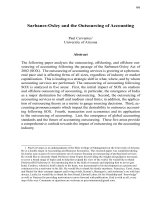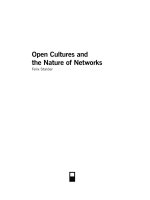Research " CULTURE AND THE EFECTIVENESS OF SUPPLIER DIVERSITY PROGRAMS: A TEST OF PREDICTORS " doc
Bạn đang xem bản rút gọn của tài liệu. Xem và tải ngay bản đầy đủ của tài liệu tại đây (314.77 KB, 84 trang )
CULTURE AND THE EFFECTIVENESS OF SUPPLIER DIVERSITY PROGRAMS:
A TEST OF PREDICTORS
by
Gwendolyn Whitfield
A Dissertation
Submitted to the
Faculty of The Graduate College
in partial fulfillment of the
requirements for the
Degree of Doctor of Philosophy
Department of Sociology
Western Michigan University
Kalamazoo, Michigan
December 2003
UMI Number: 3133550
Copyright 2003 by
Whitfield, Gwendolyn
All rights reserved.
________________________________________________________
UMI Microform 3133550
Copyright 2004 ProQuest Information and Learning Company.
All rights reserved. This microform edition is protected against
unauthorized copying under Title 17, United States Code.
____________________________________________________________
ProQuest Information and Learning Company
300 North Zeeb Road
PO Box 1346
Ann Arbor, MI 48106-1346
Copyright by
Gwendolyn Whitfield
2003
ii
ACKNOWLEDGMENTS
First and foremost, I am thankful to God for giving me the faith, ability, resources
and strength to pursue higher dreams. With God nothing is impossible.
I would like to thank my chair, Dr. Tom Vanvaley and the members of my
dissertation committee, Dr. David Hartmann, Dr. Robert Landeros and Dr. Subash
Sonnad. Thank you for the support, guidance and time you generously provided. I would
also like to thank Dr. Dan Farrell, Dr. Bruce Ferrin and Dr. David Litinsky for the unique
ways in which they helped me frame my research.
Thanks also to Dr. Joseph Cavinato and the Institute for Supply Management for
providing a dissertation grant to help make the completion of this research possible.
Finally, I would like to thank my daughter Mariah and my parents Joe and
Virginia Whitfield for their belief in me and their unwavering love and support.
Gwendolyn Whitfield.
iii
TABLE OF CONTENTS
ACKNOWLEDGMENTS ii
LIST OF TABLES vi
LIST OF FIGURES vii
CHAPTER I 1
OVERVIEW OF THE RESEARCH 1
Introduction 1
Supplier Diversity Overview 2
Primary Research Questions 4
Theoretical Framework 6
Research Methodology 8
Scope of the Dissertation 11
Contribution of the Research 12
CHAPTER II 13
LITERATURE REVIEW 13
Introduction 13
Purchasing and Supply Chain Management 13
Minority Business in the U.S. 17
Supplier Diversity 22
Organizational Culture 26
CHAPTER III 30
RESEARCH DESIGN 30
iv
TABLE OF CONTENTS—continued
CHAPTER III
Introduction 30
Research Propositions 31
Measures 31
Research Design and Data Collection 34
Design Issues for Mixed Methods 35
Sample 36
Research Methodology 38
Data Collection 38
Internet-Mediated Research 39
Validity Issues 41
Reliability Issues 43
CHAPTER IV 45
DATA ANALYSIS 45
Introduction 45
Summary Statistics 45
Analysis at the Organizational-Level 50
Results of Factor Analysis 58
Results of Reliability Test 59
Analysis for Individual Units 59
Humanistic 59
Qualitative and Quantitative Data Analysis: A Combined Approach 61
v
TABLE OF CONTENTS—continued
CHAPTER IV
Data Displays 62
Results 64
CHAPTER V 66
DISCUSSION OF THE RESULTS 66
Introduction 66
Managerial Contributions 66
Academic Contributions 67
Limitations of Research 69
Future Research 69
BIBLIOGRAPHY 70
vi
LIST OF TABLES
Table 1. Types of Cultures 9
Table 2. Unit Levels of Spending 10
Table 3. Minority Population, 2000 18
Table 4. Firms by Race and Ethnic Origin, 1997 18
Table 5. Minority-Owned Firms by Industry, 1997 19
Table 6. Growth in Number of Minority-Owned Firms, 1982-1997. 20
Table 7. Description of Culture for Diversity Instrument 34
Table 8. Buyer Data 37
Table 9. Construct Validity of the 12 Scales of the Organizational Culture Inventory 42
Table 10. Cronbach Alpha Coefficients for Scales 44
Table 11. Scale Means at the Organizational Level 51
Table 12. Factor Analysis for Culture Styles 58
Table 13. Means for Individual Units 59
Table 14. Aggregate Means for Culture Clusters 60
Table 15. Partially-Ordered Meta Matrix 63
vii
LIST OF FIGURES
Figure 1. Conceptual Model 7
Figure 2. Unit Affiliation of Respondents 46
Figure 3. Ethnicity of Respondents 47
Figure 4. Years with Organization 48
Figure 5. Gender of Respondents 49
Figure 6. Educational-Level of Respondents 50
Figure 7. Frequency for Affiliative Scale at Organizational Level 51
Figure 8. Frequency of Achievement Scale at Organizational Level 52
Figure 9. Frequency for Self-Actualizing Scale at Organizational Level 53
Figure 10. Frequency for Humanistic Scale at Organizational Level 54
Figure 11. Frequency of Perfectionistic Scale at Organizational Level 55
Figure 12. Management’s Commitment to Diversity 56
1
CHAPTER I
OVERVIEW OF THE RESEARCH
Introduction
Globalization and cultural diversity are on the rise. According to the Minority
Business Development Agency, the minority population will represent 37.4 percent of the
total U.S. population by the year 2020, and will yield purchasing power of $3 trillion
(MBDA 2000). Moreover, it is estimated that between 2000 and 2050 the majority of
new business starts will originate in the minority community (U.S. Small Business
Administration 1994).
These shifts in U.S. demography will have economic, political and social
implications. For corporations in particular, these trends represent significant changes for
supply chain management. The field of supply chain management is concerned with how
the processes of making, buying and selling goods and services are organized. It is
defined as the integration of people, resources and technology from the raw material
stage to the end-product for users and represents an intertwined, complex production and
distribution network (Leenders et al, 2002).
Firms are also beginning to recognize supply chain management as a viable
source of profit, growth and competitive advantage as companies scramble to cut costs
and increase customer value (Lancioni 2000, McGinnis 1999). One important aspect of
supply chain management is the purchasing function.
2
Purchasing can be defined as preparing and placing purchase orders for
commodities, supplies and services to minimize total cost and maximize value (Cavinato
and Kauffman 2000). According to a 1993 study by The Institute for Supply
Management, two-thirds of the CEO's and Presidents surveyed felt that the purchasing
function was very important to the overall success of the firm (Bales and Fearon 1993).
Purchasing has also been linked to playing a role in corporate strategy formulation and
implementation (Ellram 1995). Purchasing professionals rely on their relationships with
suppliers in order to carry out their purchasing responsibilities and much research has
been conducted about the importance of effective buyer/supplier relationships. We are
beginning to see the impact of wide-spread demographical shifts on supply chain
management and purchasing professional’s relationships with minority suppliers.
(Purchasing 1995 and 1996).
Supplier Diversity Overview
The interest in minority suppliers has risen lately partly because diversity is being
recognized as a key environmental change of the new century. Workforce as well as
business demographics are undergoing dramatic change. For example, from 1987 to 1997
minority businesses grew 168 percent. Currently there are 3.25 million minority owned
businesses that generate $495 billion in sales revenue and employ 4 million people
(NAPM InfoEdge 2001). Minority-owned businesses have clearly become a fast-growing
segment of the U. S. economy, growing from less than 7 percent of businesses in the U.S.
to almost 15 percent by 1997 (U. S. Small Business Administration, 2001). Yet, despite
these robust figures and the economic contributions of minority businesses, little
3
academic research has been conducted about the role of supplier diversity in helping to
support the functioning of the enterprise.
Supplier diversity is defined as a proactive business process that seeks to provide
all suppliers equal access to supply management opportunities (NAPM, InfoEdge 2001).
It promotes supplier participation representative of a diverse business community and
encourages economic development. Although supplier diversity programs have been
around for over 30 years, few have been fully institutionalized, and many have not
succeeded as planned. For example, minority suppliers face higher transaction costs,
experience difficulty in dealing with complex bureaucracy, and had to sometimes operate
in a hostile environment (Dollinger and Dailey 1989). Other major problems include
communication (Krause et. al 1999; Kauffman 2001) and corporate commitment (Krause
et. al 1999). As interest in supplier diversity mounts, it brings with it an opportunity to
increase the amount of scholarly work.
While researchers have noted the importance of corporate culture for
implementing supplier diversity programs (Min 1999; Carter, Auskalnis and Ketchum,
1999), there are no studies about the complexities between culture and supplier diversity.
To date, no empirical research has been conducted to establish a relationship between
culture and supplier diversity. This dissertation research takes an important step toward
establishing the link between a buying firm’s culture and the effectiveness of supplier
diversity programs of that firm.
4
Primary Research Questions
There has been a great deal of discussion about diversity and the prolific growth
of minority-owned businesses in academic literature and the popular press. Increased
workforce and population diversity, and the growth rate of minority-owned businesses
has brought with it unique interdependencies among differing cultures, people and social
systems. The growth rate of minority-owned businesses may present unprecedented
opportunity for firms to use innovative ways of partnering with minority suppliers to
access new markets and adapt to a changing external environment.
Supplier diversity was first introduced to U.S. businesses in the early 1970's in
response to federal legislation. Although the concept of supplier diversity has existed for
over three decades, few minority firms have found their way into the mainstream
processes of buying organizations (Dollinger, Enz and Dailey 1991.) Previous studies
have identified corporate culture as an important component of supplier diversity, but
unfortunately researchers have not conducted any empirical studies that have sought to
operationalize culture. This dissertation builds on the findings of previous studies, and
seeks to provide insight about how organizational culture affects the level of spending
with minority suppliers.
The goal of this dissertation is to investigate the linkage between culture and
supplier diversity effectiveness by answering (a) what types of organizational culture
exist among buying units (b) is there a relationship between a unit’s organizational
culture and the level of spending with diverse suppliers and (c) if there is a relationship,
what is its nature?
5
The question of effective supplier diversity initiatives is an important one to
consider as demographics shift, minority-owned businesses increase, and the challenge of
managing scare resources in an ever-changing global economy escalates. Studies have
shown that supplier diversity may provide unprecedented business opportunities for firms
seeking to enter new markets and for economic empowerment of communities. Supplier
diversity processes can result in job development and economic growth in declining
urban areas, and indirectly they may lead to additional customers for the buying firm
(Saddler 1994). Furthermore, as minority businesses are strengthened, neighborhoods and
cities improve because minority businesses provide jobs for citizens and economic
vitality to the community (Makower 1994). This research makes a scholarly contribution
by investigating the theoretical linkage between organizational culture and supplier
diversity effectiveness.
The culture of organizations is reflected in shared values and beliefs and guides
the behavior of organizational members such as buyers. Culture sets the pattern for
activities such as supplier diversity programs and it influences the personal styles
exhibited by members. In this research, these culture styles range from cooperative and
achievement-oriented to competitive and dependent.
In organizations with constructive cultures, members are encouraged to interact
with others and approach tasks in ways they help them meet higher order needs such as
satisfaction. In passive-defensive cultures members believe they must interact with others
in defensive ways that will not threaten their own security. In aggressive-defensive
cultures, members are expected to approach their work in forceful ways to protect their
status. The behaviors promoted by defensive cultures are generally less productive than
6
those being classified as constructive; moreover, they are less likely to be associated with
the effective management of diversity (Cooke 1995).
The primary purpose of most supplier diversity programs is to increase the
number of diverse suppliers and to improve the amount spent with those suppliers. In
order to determine how well a supplier diversity program is performing, it is imperative
that one consider the level of spending as one indicator of successful programs. This
research defines supplier diversity effectiveness as the level the spending with diverse
suppliers. It is recognized that other factors such are development, supplier perception
and long-term alliances may influence effectiveness, but this research will focus on level
of spending.
Theoretical Framework
The conceptual model in Figure 1 below displays the theoretical framework for
this research. This conceptual framework will explain the main things that will be
studied, the key constructs, factors and variables, and the presumed relationships among
them.
7
Figure 1. Conceptual Model
This research will test the theory that level of spending is dependent on the culture
of the buying unit. Constructive cultures should be related to high levels of spending with
diverse suppliers because this type of culture promotes diversity and productive
interpersonal relations among people with different backgrounds. When an organization’s
culture promotes diversity from within, those values will be reflected in the ways in
which buyers interact with external stakeholders such as minority suppliers. If buyers
work in an environment where all people are made to fit in and are valued, they will
reflect those values externally. Likewise, if the internal culture suppresses differences and
does not fully collaborate with people of diverse backgrounds as reflected in defensive
cultures, that attitude will be reflected in relationships with minority suppliers as well.
Agressive-
Defensive
Cultures
for Diversity
Constructive
Cultures
for Diversity
Passive-Defensive
Cultures
for Diversity
High Levels of
Spending
Moderate Levels
of Spending
Low Levels of
Spending
8
Research Methodology
The research questions were examined using a combination of techniques. A
survey designed to assess organizational cultures for diversity was used as well as
archival research and informal interviews. This integration of research techniques within
a single project has the potential to open up opportunities in all phases of the design, data
collection and analysis processes (Sieber 1992).
The survey measurement instrument, Organizational Cultures for Diversity
Inventory (Cooke 1989), is designed to determine an organization’s culture for diversity
in terms of the behaviors and norms that are expected of members. The inventory
presents a list of statements that describe some of the behaviors and ‘personal styles” that
might be expected or implicitly required of organizational members. Some of the
behavioral norms measured by the inventory promote diversity and productive
interpersonal relationships among people with different backgrounds. Other culture
norms that are measured are dysfunctional and lead to suppression of differences and
personal initiative.
In the Table 1 below, the Organizational Cultures for Diversity Inventory (OCDI)
measures 12 specific cultural norms or normative beliefs that are clustered into three
general types of cultures: Constructive, Aggressive-Defensive, and Passive-Defensive.
9
CULTURE:
Constructive Passive-Defensive
Aggressive-
Defensive
STYLE: Achievement Approval Perfectionist
Self-Actualizing Conventional Competitive
Humanistic/Encouraging Dependent Power
Affilliative Avoidance Oppositional
Table 1. Types of Cultures
As a part of organizational culture, behavioral expectations are considered to be
shared and enduring in nature. The expectations held in common by the members of a
group or organization determines the ways in which all members of the organization are
expected to approach their work and interact with others (Homans 1974). These
behavioral norms are typically considered an important part of groups or organizational
culture because they reflect the basic assumptions and values held in common by
members (Homans 1974; Martin & Schiel 1983; Schein 1985).
At the individual level, the strength of normative beliefs for these styles is
demonstrated by self-reporting the extent to which the behaviors associated with each
style is expected. At the level of shared behavioral expectations, the strength of the norms
is represented not only by members’ reports of the extent to which the behaviors are
required (based on aggregated responses), but also by the extent to which respondents
agree about these expectations. In organizations where there is a great deal of consensus
along these measures, these shared behavioral norms demonstrate a strong organizational
10
culture and a defined pattern of underlying values and ways of seeing things (Sathe 1985;
Kilmann et al. 1986; Cooke & Rousseau, 1988).
The effectiveness of supplier diversity was measured using archival methods and
was based on the amount of spending and the percentage of spending with diverse
suppliers. The idea underlying this research is that units that have constructive cultures
will value individual differences and consequently have effective supplier diversity
programs. On the other hand, defensive cultures suppress differences and don’t value
diversity.
The informal interviews and archival research revealed that it was possible for the
23 individual buying units within the firm to have different levels of spending with
diverse suppliers. As shown in Table 2, the units have minority-spending ranging from
less than one percent to twenty-two percent.
UNIT MINORITY SPENDING
(Percentage of Total)
LEVEL
(For Comparison)
2 22% High
4 4.5% High
5 3.6% High
1 3.4% High
2 3.0% Moderate
8 2.00 Moderate
7 2.5% Moderate
3 2.5% Moderate
6 2.3% Moderate
9 .6% Low
11 .9% Low
10 1.4% Low
Table 2. Unit Levels of Spending
11
In an effort to distinguish variation in minority spending, the units were placed in
categories for the purpose of comparison. Eleven out of the twelve units had spending
levels under 5 percent. The unit with 22 percent spending could be considered an outlier.
The cut off points were determined by grouping numbers that were as close together as
possible.
Units with 3.4-22% minority spend were considered to have high spending levels.
Units with spend from 2-3.3% were considered to have moderate spending levels, and
units with less than 2% were considered to have low levels of spending in supplier
diversity. A sample of three to five units at each spending level was targeted. There were
23 units overall. Table 2 identifies the twelve units that comprise the sample. This
includes three units with high spending levels, five units with moderate and three with
low.
Scope of the Dissertation
The concepts in Figure 1 are not all inclusive. All of the relevant factors and
linkages that influence effective supplier diversity programs have not been identified.
This dissertation will investigate the presence of a relationship between cultures for
diversity in a multi-unit organization and the levels of supplier diversity spending within
those units. This dissertation will not investigate other factors such as buyer’s personal
bias that may influence supplier diversity effectiveness beyond culture.
12
Contribution of the Research
Although there are issues that this dissertation will not examine, what this
research does investigate is important for several reasons. First, the proliferation of
minority business growth and population increases has created new challenges and
opportunities for competing and managing resources. Second, little academic research
had been conducted in this area and the need for understanding supplier diversity is
important because of the new competitive landscape within which firms operate. Third,
while culture has been casually linked to supplier diversity, it has not been empirically
tested. This dissertation will take a critical step towards investigating the theoretical
linkages between a firm’s culture and the success of supplier diversity programs. The
primary purpose is to uncover the cultural reality of each unit in the firm, determine the
effectiveness of their supplier diversity program and analyze the relationship between
organizational culture and supplier diversity effectiveness.
13
CHAPTER II
LITERATURE REVIEW
Introduction
This research spans a number of different areas that are both distinct and
interrelated. Literature reviews were conducted in purchasing, supply management,
minority businesses, supplier diversity and organizational culture. The reviews revealed a
number of interesting trends and environmental factors that present challenges and
opportunities for firms seeking competitive advantage.
Purchasing and Supply Chain Management
Today, a typical manufacturing firm procures thousands of products from
hundreds of suppliers, resulting in a complex procurement process. Purchasing, as a
business function, has a significant impact on many key components of a firm’s
operations such as acquisitions, raw materials, invoicing and logistics. The purchasing
function helps to create a competitive advantage by developing successful relationships
with suppliers and internal clients. These strategic relationships help improve new
product development, speed up market cycle times, drive out costs from both the firm and
their suppliers’ operations, and achieve strategic financial results (Wisner and Tan 2000).
14
A buyer is a purchasing professional who understands the industry in which he
competes and manages resources and relationships to achieve organizational goals such
as getting the right products at the right time for the right prices. Buyers achieve these
outcomes through effective negotiations and contracting, practices which have evolved
dramatically over the last 90 years.
It is difficult to establish, with complete accuracy the first occurrence of
commercial negotiations, however, early negotiations can probably be traced back to
transactions along the Chinese trading route. By the 1920’s, the principal function of
purchasing was to buy for less, with the initial first cost being the primary function for
many firms (Cavinato 2000). The oil shock of the 1970’s, however, resulted in significant
changes in the development of supply chain planning and shifted the focus from buying
for less to the total cost of ownership (Cavinato 2000).
Many firms reacted to this shift with a short-term focus in order to ensure cost,
reliability and continuity, resulting in win/lose negotiations with suppliers. Soon,
however, buyers realized that more cooperation and collaboration was needed to achieve
continuous improvements. The need for total cost to market improvements and
responsiveness to markets, and the need for increased levels of integration and
collaboration among suppliers and purchasing firms, gave rise to the term “strategic
purchasing”. Today many say that purchasing has evolved into supply chain
management, which implies a broader range of responsibility as well as many layers of
negotiation.
15
For the purposes of this dissertation, supply chain management has been defined
as the integration of supply chain activities to achieve sustainable competitive advantage
(Handfield and Nichols 1999). It integrates several key functions including purchasing.
While the concept of supply chain management may still be evolving, the term was
initially coined to describe the integration of logistics and physical distribution functions
used in wholesaling and retailing to reduce delivery lead times. A widely accepted
approach to supply chain management is an integrated one whereby within firm and
between firm integration is emphasized in order to provide value to the end user.
Manufacturers and service providers are now using the term to describe
integration efforts and collaboration between buyers and suppliers. Overall, however, it
can be said that the goals of integrating supply chain activities are to reduce cost and to
improve quality and delivery timing, which requires good relationships with suppliers.
The concept of the supply chain management appeared in literature only as
recently as the 1980’s. However, the assumptions that support the concept can be traced
back to the 1960’s when the flow of materials began receiving a lot of attention.
Researchers and practitioners recognized the linkages that exist in the supply of materials
and the flow of information. They began to consider all members in this chain as
critically important. The short-term objective of supply chain management is
concentrated primarily on increasing productivity and reducing inventory and cycle
times. The long-term goals are more strategic in nature and include customer satisfaction,
increased market share and profits.
16
Purchasing is a critical link in the chain because it connects the sources of supply
with the organization. For example, if suppliers are involved early in production design,
manufacturers can select the best and most economical components, materials and
technologies from alternatives (Burt and Soukup 1985). Further, supplier involvement in
product design and continuous improvement activities can have a positive impact on
competitive advantage and firm performance (McGinnis and Vallopra 1999;
Vonderembse and Tracey 1999).
The term “supply chain management” is a new management philosophy that fully
enables firms to compete in an evolving landscape. The intensity of global competition
and the gaining popularity of the Internet as a business tool has created a competitive
environment dominated by low cost, high quality products and services in a highly
innovation competitive environment. Manufacturers have had to incorporate supplier
strengths and technologies in new product development into their processes (Morgan and
Monczka 1995). Hence, supply chain management has been adopted to conceptualize the
focus on integrating and partnering with suppliers, and integrating the logistics and
transportation functions to effectively manage the supply chain.
A great deal of the recent literature on supply chain management focuses on
integration processes and supplier alliances to create customer satisfaction and realize
business goals (Carter 2000). The increased need for supplier integration and partnering
has important implications for supplier diversity since it is estimated that the majority of
new business starts will originate in the minority community. It will become increasing









